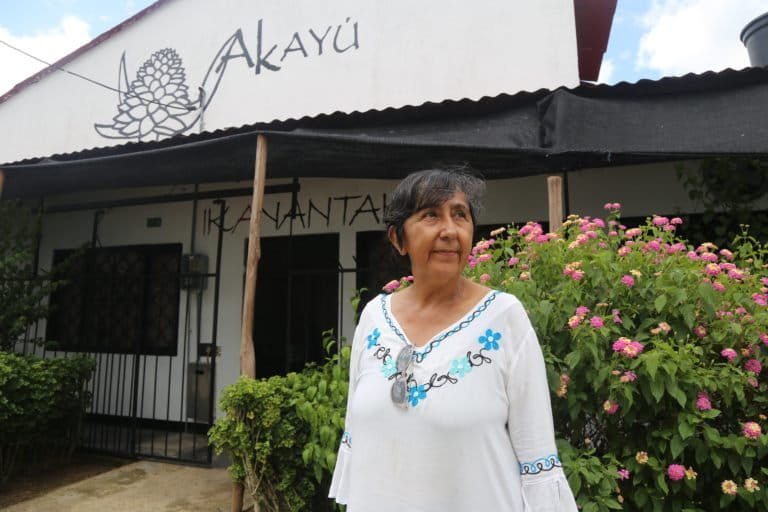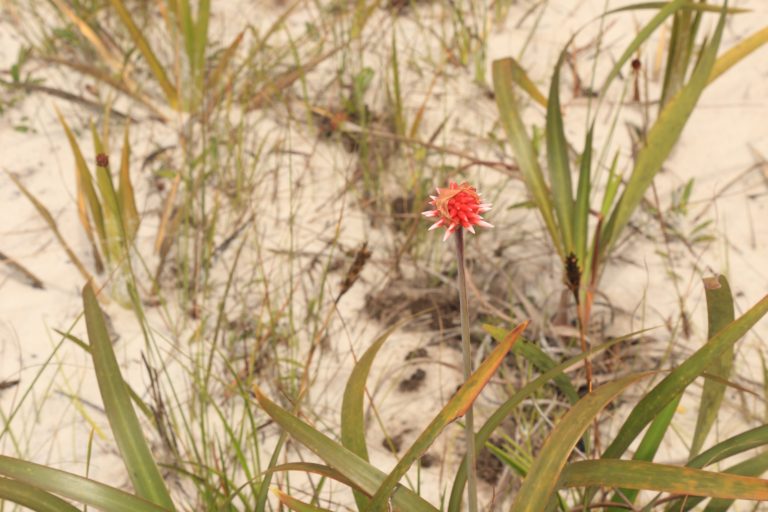- The Inírida flower, known as flor de Inírida, grows in a small area along the Colombian-Venezuelan border.
- An Indigenous leader and botanist successfully worked together to domesticate this rare and little-known flower.
- Its conservation helps ensure the long-term protection of other species while offering potential bioremediation against contaminated soil.
- Inírida’s commercialization plays a vital role in the region’s green economy, bringing in revenues for Indigenous families.
INÍRIDA, Colombia –– Carolina Mora Gaitan takes one of the striking-looking flowers from the blue bucket lying at her feet and shakes off the excess water. Using a toothbrush, she scrubs away any trace of dirt and proceeds to peel away an unsightly brown leaf with a pair of tweezers. Sitting opposite, her daughter-in-law mirrors her actions.
Alongside them, Carolina’s husband and son clip, classify and box the fuchsia-colored flowers with meticulous precision. They have been involved in the Inírida flower trade in Colombia’s eastern Guainía department since it began more than a decade ago. The trade has changed significantly from its early days when the flower was freshly picked from the wild. Today, a successful process of domestication once considered impossible ensures its long-term preservation, while simultaneously contributing to conservation efforts in this unique region.
The Guacamaya superba or the Inírida Winter flower grows throughout Guainía’s long rainy season, eventually giving way to the smaller Schoenocephalium teretifolium or the Inírida Summer flower, which blooms during the rest of the year. Both are known as flores eternas (everlasting flowers), on account of their ability to resist extreme weather conditions, and their natural propensity to keep their physical shape, long after their vibrant colors have faded.

Carolina and her family are members of Colombia’s Sikuani people — one of the country’s 87 recognized Indigenous groups and also one of the most displaced by the armed conflict.
Twenty-five years earlier, Carolina’s family were forced to leave their home and land during the 1997 massacre of Mapiripán, a small fluvial town in central Colombia, in which at least 30 civilians were brutally murdered by right-wing paramilitaries. Overnight, Carolina and her family were left destitute. Indigenous people account for 80% of the population in Guainía, which has a large intake of migrants due to forced internal displacement, as well as migrants from Venezuela.
They eventually settled in the small port town of Inírida, capital of Guainía – “land of many waters” in the Yurí language — in the remote northeastern edges of the Colombian Amazon, on the Venezuelan border. Initially, they survived thanks to the local landfill. What others discarded, they treasured: a pair of well-worn shoes, a rusty bike, a bag of old clothes. Informal waste picking provided the family with an economic lifeline.

It was through her recycling work that Carolina first met Martha Toledo, a teacher and founder of Akayú, a not-for-profit focused on sustainable development and education.
Working with Indigenous women, Toledo launched a recycling scheme where they collected and sorted the town’s waste, which was then returned to the capital for treatment. This brought in modest revenues for families while also reducing the town’s plastic problem — the result of its reliance on imports.
Guainía has more to offer than just sifting through imported waste, however. Working with the environmental government agency Corporation for the Sustainable Development of the Northern and Eastern Amazon (CDA), Toledo was awarded a license to sell the Inírida flower.
“The idea has always been to demonstrate that the region is capable of being productive,” says Toledo.

For the longest time, Guainía has been overlooked by the rest of the country and communities forgotten about: “We needed something to put us on the map,” she says.
The Flor de Inírida, with its eye-catching, exotic beauty, was an opportunity to do just that. “If the world can’t come to Inírida, then Inírida must go to the world,” says Toledo. The flowers are sold through LIWI, the commercial arm of Akayú, translating to flower in Curripaco.
Despite serving as the official town symbol, many people have never heard of Inírida, much less its namesake flower, taken from the Puinave word meaning espejito de sol (little sun mirror).
The flower proved popular, with orders coming in from major cities across the country and interest from abroad. ”We had many families involved, from planting, harvesting, and prepping,” says Toledo.
Picking flowers from their natural habitat, however, was not a viable long-term solution. It became clear that they needed to figure out a way to domesticate Inírida.

At the time, Inírida’s remote location and Colombia’s complex history meant few scientists had researched the area and its ecosystem at length. The few limited studies focused on the flower had concluded it was impossible to grow.
Cultivation process
Rubén Darío Carianil, Toledo’s husband and a Curripaco community leader, believed otherwise. He knew how rare the Inírida flower was and could pinpoint the few locations dotted around Guainía where it flourished.
“Everything I know about the environment, I was taught by my father and grandfather [well-respected sabedores or savants]. Like other communities here, our knowledge as Curripaco and Indigenous custodians of the land goes back millennia,” says Carianil.
This included knowing the Earth’s natural harvesting cycle and following the guidance of the stars in order to know when it is time to seed or sow, he says.
Paramount in their Indigenous cosmology is the role of lunar constellations in determining the agricultural cycle. From an agronomy perspective, Guainía offers challenging terrain for farmers. Yet, over the course of generations, Indigenous communities like the Curripaco, Puinave, Piapoco, and Tucano have perfected their practices to get the most from the nutrient-poor soil, producing high crop yields in relatively small parcels of land. Such knowledge systems are cumulative and the result of generations of lived experiences stored in the collective memory and passed orally from parents to children.

“I knew if we could apply that knowledge, we stood a chance,” says Carianil.
With the help of Mateo Fernández Lucero, today a biologist at the Humboldt Institute, they conducted a series of experiments combining ancestral knowledge and scientific theory. A plot of land apt for propagation was identified and subsequently bought. Eventually, the two men deciphered the Flor de Inírida’s biological secrets. Cuttings from lateral shoots spaced out in a raised bed and a tailored water regime yielded the best results, achieving a mortality rate of less than 1% in their dedicated nursery, while elsewhere, some threatened populations were even restored.
“When you visit, you shouldn’t even notice you’re in the middle of a plantation,” says Carianil.
So effective is the distribution, the rows, arranged diagonally, are only noticeable once pointed out: “It’s supposed to look and feel like the natural environment in which it grows, which is to say the wild,” adds Fernández Lucero.
Thanks to the Cerros de Mavecure, Inírida is slowly emerging as a tourist destination (although many still remain unaware of its existence). The three giant monoliths are located 50 km south of Inírida, on the Atabapo River, and are the main attraction for travelers wanting to go off the beaten path.

The Inírida flower flourishes in the shadow of the Cerros (hills), one of the world’s richest biodiversity hotspots. At 1.7 billion years old, they are also among the world’s oldest rock formations. Specifically, the Flor de Inírida finds refuge in the fine white sand savannas of the Estrella Fluvial (Fluvial Star) Ramsar site, the designation making it one of the most biologically important wetlands on the planet. The almost powder-like grains of sand are the product of a process of erosion lasting millions of years.
“These lands have very particular fertility conditions, whereby the absence of nutrients predominates; a thin topsoil offers very low rates of fertility, often with very high concentrations of aluminum,” says Fernández Lucero. “Add to that the area’s adverse weather conditions, resulting in flooding, fires, and drought these flowers have learned to adapt to their inhospitable environment.”
According to research published by Fernández Lucero and colleagues, the concentration of noxious metals was up to six times higher in the flowers than in the surrounding soil, suggesting a natural capacity to extract high levels of aluminum. Due to this resistance, they concluded that the Inírida flower “could help bioremediate and decontaminate soils affected, anthropogenically, by this metal. Taking into account that aluminum inhibits root growth and proliferation in most plants, this would be an important ecological contribution to restore degraded areas”.

The Flor de Inírida is, in conservation terms, an umbrella species: protecting Inírida indirectly protects the many other, often less charismatic species — as many as 94 of them, including the Bactris campestris Poepp. palm tree — that make up the ecological community within its unique ecosystem.
“We wanted to demonstrate that it was possible — even in a place such as Guainía – to contribute to a model that was greener and more sustainable. But also realistic, because there can be no sustainable development if people are hungry — hunger leads to more invasive and extractive practices,” says Fernandez Lucero.
“In order to decrease pressure on local, natural resources, you find a way to render those same resources sufficiently productive for a maximum number of vulnerable people, thus ensuring the ecosystem’s preservation.”
Step outside the “productive reserve,” as Fernández Lucero refers to it, and there is ample evidence of anthropogenic change, with land use being transformed for construction and grazing. While there is nothing to indicate that the Inírida flower is at risk of extinction, this transformation of soil in the heart of Inírida territory (which is naturally so very small), represents a very real threat to its survival.
Back in the cool shelter of LIWI, the last of the flowers have been packed, ready to be shipped in tomorrow’s flight to Bogota, where the price averages 4,000-5,000 COP a head. Bought directly in Inírida, however, the Winter flower sells for 1,600 and the smaller Summer flower for 1,000. LIWI typically sells 60,000 flowers a year. Last year, despite the pandemic, they sold 89,000 of them.

Carolina –- still affected by the trauma of being dispossessed from her land and home –- says the flower has helped transform the lives of her family. In Inírida, where the median income is 40,000 pesos for a full day’s work, Carolina can earn 50,000 in just half.
“I am a very modest woman. I don’t have much of an education,” she says, apologetically. “But [through Inírida] I’ve been able to help put my children through school.”
The flor de Inírida has adapted to survive against the odds. Through its domestication, Akayú and LIWI aim to demonstrate Guainía’s untapped potential and provide the region with a much-needed green alternative.
Banner image: A beetle on an Inírida flower. Image courtesy of Soraya Kishtwari for Mongabay.
Related listening from Mongabay’s podcast: A conversation with Victoria Tauli-Corpuz and Zack Romo about Indigenous rights and the future of biodiversity conservation. Listen here:
FEEDBACK: Use this form to send a message to the author of this post. If you want to post a public comment, you can do that at the bottom of the page.
